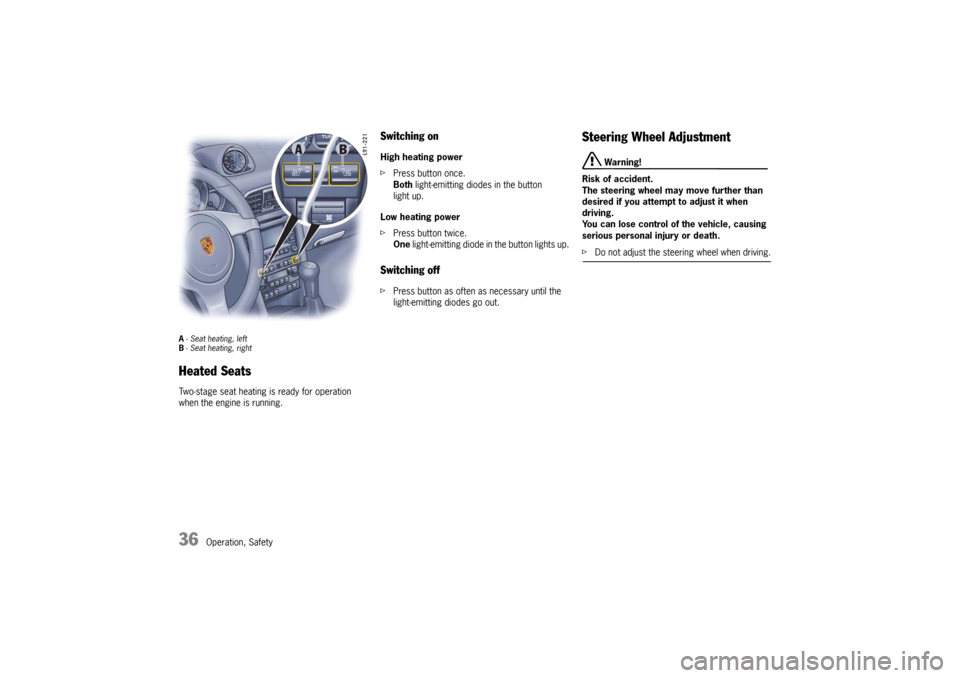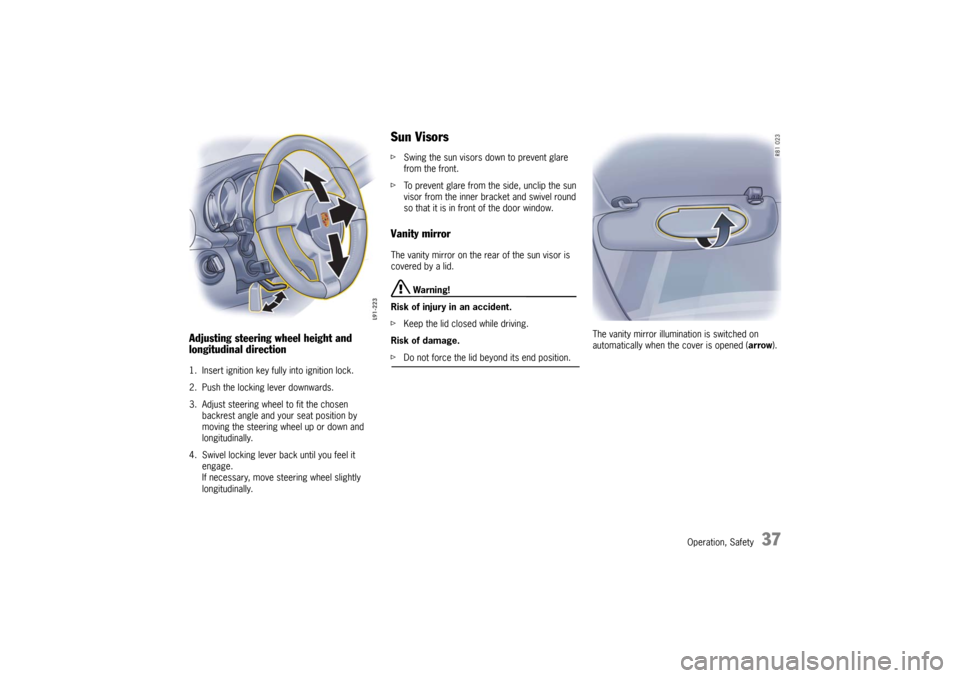steering PORSCHE 911 GT3 2010 5.G User Guide
[x] Cancel search | Manufacturer: PORSCHE, Model Year: 2010, Model line: 911 GT3, Model: PORSCHE 911 GT3 2010 5.GPages: 251, PDF Size: 14.33 MB
Page 34 of 251

Operation, Safety
33
Seat Adjustment and Head
Restraints
Warning!
The seat may move unexpectedly if you
attempt to adjust while driving. This could
cause sudden loss of control, resulting in
serious personal injury or death.
fDo not adjust seats while the vehicle is in
motion.
The backrest locks must be engaged at all
times while the vehicle is in motion.
Safety belts only offer protection when the
backrest is upright and the belts are properly
positioned on the body.
Improperly positioned safety belts or safety
belts worn by passengers in an excessively
reclined position can cause serious personal
injury or death in an accident.
fDo not operate the car with the driver or
passenger backrests excessively reclined
(see “Seat position”).
Risk of injury if persons or animals are in the
movement range of the seat during seat
adjustment.
fAdjust the seat so that no one is put at risk.
Caution!
Risk of damage to windshield, sun visor, etc.
when the seat is adjusted or folded back or
forward.
fAdjust the seat so that the seat backrest is not in contact with any other object.
The driver and passenger seat provide integrated
head restraints in the backrests. The head
restraints are not adjustable. Warning!
All occupants, including the driver, should not
operate a vehicle or sit in a vehicle's seat until the
head restraints and backrests, respectively, are
placed in their proper positions so that the risk of
neck injuries is minimized in the event of a crash.
For proper positioning of the head restraint, the
seatback's inclination should be adjusted such
that the head restraint is in an upright position.
Driver and passengers should be seated upright
and in the center of their seats.
Seat positionAn ergonomically correct sitting position is
important for safe and fatigue-free driving.
We recommend the following procedure for adjus-
ting the driver’s seat to suit individual
requirements:
1. Adjust the seat until, with the clutch pedal fully
depressed, your leg remains at a slight angle.
2. Rest your outstretched arm on the steering
wheel.
Set the backrest angle (not applicable for
Sports bucket seat) and the steering-wheel
position so that your wrist rests on the outer
rim of the steering wheel. At the same time,
the shoulders must still be in noticeable
contact with the backrest.
3. Adjust the seat height (not applicable for
Sports bucket seat) to give yourself enough
headroom and a good overview of the vehicle.
4. Electrically adjustable seat:
Adjust the seat angle until your thighs rest
lightly on the seat cushion.
10_GT3_21.book Seite 33 Donnerstag, 4. Juni 2009 12:48 12
Page 37 of 251

36
Operation, Safety
A- Seat heating, left
B- Seat heating, rightHeated SeatsTwo-stage seat heating is ready for operation
when the engine is running.
Switching onHigh heating power
fPress button once.
Both light-emitting diodes in the button
light up.
Low heating power
fPress button twice.
One light-emitting diode in the button lights up.Switching offfPress button as often as necessary until the
light-emitting diodes go out.
Steering Wheel Adjustment
Warning!
Risk of accident.
The steering wheel may move further than
desired if you attempt to adjust it when
driving.
You can lose control of the vehicle, causing
serious personal injury or death.
fDo not adjust the steering wheel when driving.
10_GT3_21.book Seite 36 Donnerstag, 4. Juni 2009 12:48 12
Page 38 of 251

Operation, Safety
37
Adjusting steering wheel height and
longitudinal direction1. Insert ignition key fully into ignition lock.
2. Push the locking lever downwards.
3. Adjust steering wheel to fit the chosen
backrest angle and your seat position by
moving the steering wheel up or down and
longitudinally.
4. Swivel locking lever back until you feel it
engage.
If necessary, move steering wheel slightly
longitudinally.
Sun VisorsfSwing the sun visors down to prevent glare
from the front.
fTo prevent glare from the side, unclip the sun
visor from the inner bracket and swivel round
so that it is in front of the door window. Vanity mirror The vanity mirror on the rear of the sun visor is
covered by a lid.
Warning!
Risk of injury in an accident.
fKeep the lid closed while driving.
Risk of damage.
fDo not force the lid beyond its end position.The vanity mirror illumination is switched on
automatically when the cover is opened (arrow).
10_GT3_21.book Seite 37 Donnerstag, 4. Juni 2009 12:48 12
Page 42 of 251

Operation, Safety
41
Airbag SystemsThe airbags in combination with the safety belts
make up a safety system which offers the driver
and the passenger the greatest known protection
from injuries in case of accident.
Your vehicle is equipped with a weight sensing
system for the passenger's seat in accordance
with U.S. Federal Motor Vehicle Safety Standard
208.
Even if your vehicle is equipped with airbags, the
safety belts must be worn at all times,
because the front airbag system is only deployed
by frontal collisions with an impact of sufficient
severity.
Below the deployment threshold of the airbag
system, and during types of collisions which do
not cause the actuation of the system, the safety
belts provide the primary protection to the occup-
ants when correctly worn.
Therefore, all persons within the vehicle
must wear safety belts at all times (in many
states, state law requires the use of safety belts).
fPlease see the chapter “SAFETY BELTS” on
Page 38.
The front airbags are located under the padded
steering wheel panel on the driver’s side and, on
the passenger's side, in the dashboard.
The side airbags for the front seats are installed
on the side in the seat backrests.
The head airbags are installed in the door linings.
Danger!
To provide optimal occupant protection,
airbags must inflate at very high speed. If
you are not wearing your safety belt or are
too close to the airbag when it is deployed,
inflating airbags can result in serious
personal injury or death.
fMake sure there are no people, animals or
objects between the driver or passenger and
the area into which the airbag inflates.
fSit back as far from the dashboard or steering
wheel as is practical, while still maintaining full
vehicle control.
fAlways hold the steering wheel by the outer
rim. Never rest your hands on the airbag panel.
fAlways fasten seat belts because triggering
of the airbag system depends on the force and
angle of impact.
fDo not transport heavy objects on or in front of
the passenger’s seat. These could impair the
function of the airbag, the seat belts, and
weight sensing.
fDo not hang objects (e.g. jackets, coats, coat
hangers) over the backrest.fAlways keep the lid of the door storage
compartment closed. Objects must not
protrude out of the door storage compart-
ment.
fDo not add any additional coverings or stickers
to the steering wheel or in the area of the
passenger’s airbag, side airbags and head
airbags. Doing so may adversely affect the
functioning of the airbag system or cause
harm to the occupants if the airbag system
should deploy.
Do not use protective seat covers.
fDo not modify the seat coverings. Do not
attach additional cushions, protective cover-
ings, or pillows to the passenger's seat. Do not
affix things to the passenger's seat or cover it
with other materials. Do not cover the back of
the backrest. Do not make changes to the
passenger's seat and to the seat base frame.
fNo changes may be made to the wiring or
components of the airbag system.
fDo not install any wiring for electrical acces-
sory equipment in the vicinity of the airbag
wiring harnesses. Doing so may disable the
airbag system or cause inadvertent inflation.
fIf the warning light comes on, the airbag
system should be repaired immediately by
your authorized Porsche dealer.
10_GT3_21.book Seite 41 Donnerstag, 4. Juni 2009 12:48 12
Page 43 of 251

42
Operation, Safety fAlways keep feet in the footwell while driving.
Do not put feet on the dashboard or the seat
area. Do not lean against the inside of the door
or outside the window while the vehicle is
moving.
fUsing accessories not approved by Porsche
can cause the weight sensing system to be
impaired.
fDo not squeeze objects, such as the fire extin-
guisher, or first aid kit under the seat.
fOnly have seats removed and installed by an
authorized Porsche dealer so that weight
sensing components will not be damaged.
fGive your passenger all of the information in
this chapter.
Note
Airbag components (e.g. steering wheel, door
lining, seats) may be disassembled only by an
authorized Porsche dealer.
When disposing of a used airbag unit, our safety
instructions must be followed. These instructions
can be obtained at any authorized Porsche dealer.
Function of the airbag systemAirbags are a supplemental safety system. Your
primary protection comes from your safety belts.
The front airbags are triggered during a frontal
collision of sufficient force and direction.
In the event of a side impact of corresponding force, the side airbag on the impact side is
triggered.
The inflation process generates the amount of gas
required to fill the airbags at the necessary
pressure in fractions of a second.
Airbags help to protect the head and upper body,
while simultaneously damping the motion of the
driver and passenger in the impact direction in the
event of a frontal impact or side impact.
In order to help provide protection in severe colli-
sions which can cause death and serious injury,
airbags must inflate extremely rapidly. Such high
speed inflation has a negative but unavoidable
side effect, which is that it can and does cause
injuries, including facial and arm abrasions,
bruising and broken bones. You can help minimize
such injuries by always wearing your safety belts.
There are many types of accidents in which
airbags are not expected to deploy. These include
accidents where the airbags whould provide no
benefit, such as a rear impact against your
vehicle. Other accidents where the airbags are
designed not to deploy are those where the risk of
injury from the airbag deployment could exeed any
protective benefits, such as in low speed
accidents or higher speed accidents where the
vehicle decelerates over a longer time. Since
airbag deployment does not occur in all accidents,
this further emphasizes the need for you and your
passenger to always wear safety belts.Your vehicle is equipped with a crash sensing and
diagnostic module. This module will record the
use of the seat belt restraint system by the driver
and passenger when the airbags and/or belt tensi-
oner work.
Advanced AirbagYour vehicle is equipped with a weight sensing
system for the passenger's seat in accordance
with U.S. Federal Motor Vehicle Safety Standard
208.
Depending on the weight acting on the
passenger's seat, the passenger's airbag will
automatically be switched on and off.
Depending on the angle and force of impact, the
passenger's airbag which is activated will be
triggered during a collision.
Precondition for switching the passenger's airbag
on and off, depending on weight:
– Vehicles equipped with key-operated airbag
deactivation device:
Switch position AUTO.
– Ignition key is inserted.
Improper handling of the weight sensing
system can unintentionally impair switching
the passenger’s airbag off and on.
10_GT3_21.book Seite 42 Donnerstag, 4. Juni 2009 12:48 12
Page 58 of 251

Operation, Safety
57
ABS Brake System
(Antilock Brake System)The ABS system represents a major contribution
to the enhancement of active safety in your
vehicle. This system prevents the wheels from
locking in a panic stop on almost all road
surfaces. With the ABS system in your vehicle, the
following areas are enhanced: Steering, vehicle remains steerable under all
braking forces when ABS is engaged.
Good directional control, no swerving caused
by locking of wheels under braking conditions.
Shorter stopping distance, stopping distances
are usually reduced because controlled braking is
maximized.
Prevention of wheel lock up, no brake-induced
sliding and thus no localized tire wear from
emergency braking.
The crucial advantage of the ABS system over a
conventional brake system is in the area of
maintaining directional control and maneuverabi-
lity of the car in emergency situations.
Warning!
The increased control that is provided should
not induce you to take greater risks with your
safety. The limits dictated by the laws of
physics cannot be overcome, even with ABS.
The risk of accidents due to inappropriate
speed cannot be reduced, even by the ABS.
The driver bears the responsibility for all
driving maneuvers.
fAdapt your driving style to the prevailing road
and weather conditions.
fObey all traffic laws.
Other vehicles not equipped with the ABS
system may not be able to maintain control,
especially on wet or poor road surfaces and
thus may be more likely to impact you from
behind.
fTo minimize that risk, use your ABS system to
increase your ability to maneuver to avoid
dangerous situations and not merely to try to stop in the shortest distance possible.
Operation of the ABS systemA wheel speed sensor is mounted to each of the
four wheels. If wheel lock-up of either of the front
wheels or the rear wheels is sensed during
braking, the brake pressure is adjusted automati-
cally until the wheel no longer slips.
If braking forces approach the wheel lock-up point
for all wheels (panic braking) the ABS system will
intervene to provide a rapid rythmic braking. The
proper operation of ABS is perceived by the driver
as a pulsating brake pedal in conjunction with
audible noise and perhaps some vibration.
fIf you experience these sensations while
driving or a road surface with questionable
traction, reduce vehicle speed appropriate for
the prevailing road conditions.
fIf full braking should be necessary, press the
brake pedal all the way down throughout the
entire braking procedure, regardless of the
pulsating pedal. Do not ease up on pressure
applied to the pedal.
The functional readiness of all the main electrical
components of the ABS is checked by an
electronic monitoring system both before and
while you drive.
10_GT3_21.book Seite 57 Donnerstag, 4. Juni 2009 12:48 12
Page 60 of 251

Operation, Safety
59
Porsche Stability Management
(PSM)PSM is an active control system for stabilization of
the vehicle during extreme driving maneuvers.
Warning!
Risk of an accident, resulting in serious
personal injury or death.
The increased control that is provided should
not induce you to take greater risks with your
safety. The limits dictated by the laws of
physics cannot be overcome, even with PSM.
The risk of accidents due to inappropriate
speed cannot be reduced, even by PSM.
The driver bears the responsibility for all
driving maneuvers.
fAdapt your driving style to the prevailing road
and weather conditions.
fObey all traffic laws.
Sensors at the wheels, brakes, steering system
and engine continuously measure:
–Speed
– Direction of travel (steering angle)
– Lateral acceleration
– Rate of turn about the vertical axis
– Longitudinal accelerationPSM uses these values to determine the direction
of travel indicated by the driver.
PSM intervenes and helps to correct the course if
the actual direction of motion deviates from the
chosen course (steering-wheel position):
It brakes individual wheels as needed. In addition,
the engine power may be manipulated in order to
stabilize the vehicle.
The events below inform the driver of PSM control
operations and warn him/her to adapt his/her
driving style to the road conditions:
– The multifunctional information light on the
instrument panel flashes.
– Hydraulic noises can be heard.
– The vehicle decelerates and steering-wheel
forces are altered as PSM controls the brakes.
– Reduced engine power.
– The brake pedal pulsates and its position is
changed during braking.
In order to achieve full vehicle deceleration,
foot pressure must be increased after the
brake pedal has begun vibrating.
Advantages of PSM– Improved traction and lane-holding ability in all
driving situations – even on road surfaces with
varying friction.
– The system compensates for undesired lateral
vehicle reactions when the driver releases the
accelerator pedal or brakes when cornering.
This compensation functions up to the
maximum lateral acceleration.
– PSM actively helps stabilize the vehicle as
required during dynamic driving maneuvers
(e.g. rapid steering movements, during lane
changes or on alternating bends).
– Improved braking stability in curves and on
different or varying road surfaces.
10_GT3_21.book Seite 59 Donnerstag, 4. Juni 2009 12:48 12
Page 66 of 251

Operation, Safety
65
Lowering front axle fPress button in the center console.
The vehicle is lowered to the basic level.
The light-emitting diode in the button and in the
tachometer goes out.
Caution!
Risk of damage through bottoming out the
vehicle.
fDo not lower the vehicle when it is positioned above an obstacle.
Notes on operation
Warning messageFront axle lift system faults are indicated by
a warning message on the on-board computer.
fPlease see the chapter “WARNINGS ON THE
INSTRUMENT PANEL AND THE ON-BOARD
COMPUTER” on Page 148.
– When raised, the damping properties of the
front axle change and noise may be heard in
the area of the front axle coil springs during
steering movements.
– The doors must be closed when lowering the
front axle.
–The blowing-off procedure may result in
system-related hissing noise. This does not
represent a malfunction in the lift system.– During extended vehicle immobilization, the
pressure accumulator may be completely
emptied. In this case, the first time the axle is
raised, a period of up to 2 minutes may elapse
before the vehicle height is reached and “LIFT”
is displayed.
– A flashing LED in the button indicates that the
system is currently not available. Possible
causes may be:
> Automatic overload protection is active.
The system will be available again
following a brief cooling-down phase.
The cooling-down phase may be
extended when outside temperatures
are very high.
> The speed threshold of 30 mph
(50 km/h) has been exceeded. The
system will be available again once the
speed falls below the threshold.
> If automatic lowering is actuated by
exceeding a speed of approx. 30 mph
(50 km/h) in combination with hard
acceleration, the required lowering
duration may mean that “LIFT not
lowered” is displayed. The display goes
out again as soon as the front axle has
been completely lowered.
10_GT3_21.book Seite 65 Donnerstag, 4. Juni 2009 12:48 12
Page 68 of 251

Operation, Safety
67
O - Initial position
1 - Ignition on
2 - Start engine
3 - Ignition offIgnition/Starter Switch with
anti-theft Steering Lock
Caution!
Risk of damage. If extra weight has been
added to the inserted ignition key such as,
e. g. a heavy bunch of keys and/or a key
fob, the ignition lock may be damaged.
fDo not attach any extra weight to the inserted ignition key.The ignition lock has a total of four ignition lock
positions.
The ignition key rebounds to the initial position
from every ignition lock position.
fFor your safety, fasten safety belts.
fPlease see the chapter “IMMOBILIZER” on
Page 18.
fPlease see the chapter “KEY WITH RADIO
REMOTE CONTROL” on Page 19.
Before starting the enginefApply the footbrake.
fMove the gearshift lever into neutral.
The clutch pedal must be depressed fully
before the starter will engage.Switch position 0 Initial position
The ignition key cannot be withdrawn when the
ignition is switched on or when the engine has
been started.
To withdraw the ignition key:
fStop the vehicle.
fSwitch ignition off.
fRemove ignition key.
Switch position 1 Ignition on
fTurn ignition key to position 1.
Ignition is switched on.
Note on operation
All electrical equipment can be switched on.
fPlease see the chapter “WARNINGS ON THE
INSTRUMENT PANEL AND THE ON-BOARD
COMPUTER” on Page 148.
10_GT3_21.book Seite 67 Donnerstag, 4. Juni 2009 12:48 12
Page 69 of 251

68
Operation, Safety
Switch position 2Start engine
fTurn ignition key to ignition lock position 2.
fPlease see the chapter “STARTING PROCE-
DURES” on Page 70.Switch position 3Ignition off
fTurn ignition key to ignition lock position 3.
Note on operation
The vehicle battery discharges if the ignition key is
left inserted.
If the vehicle battery is dead, the key can only be
pulled out of the ignition lock if the emergency
operation is performed:
fPlease see the chapter “EMERGENCY OPERA-
TION – PULLING OUT THE IGNITION KEY” on
Page 69.
Locking the steering columnAutomatic locking
The steering column is automatically locked when
the ignition key is withdrawn from the ignition lock.
Warning!
Risk of an accident, resulting in serious
personal injury or death.
The steering wheel will lock and will cause
loss of steering.
fNever remove key from the ignition lock or turn
the key off while the vehicle is moving.
fAlways withdraw the ignition key when leaving the vehicle.Automatic unlocking
The steering column is unlocked when the vehicle
is unlocked with the radio remote control.
Note
fTo avoid discharging the battery, always
remove the ignition key from the ignition lock.
Please see the chapter “BATTERY” on
Page 211.
Gong If you leave the key in the ignition/steering lock, a
gong will sound when the driver’s door is opened.
This is a reminder to remove the key.
10_GT3_21.book Seite 68 Donnerstag, 4. Juni 2009 12:48 12